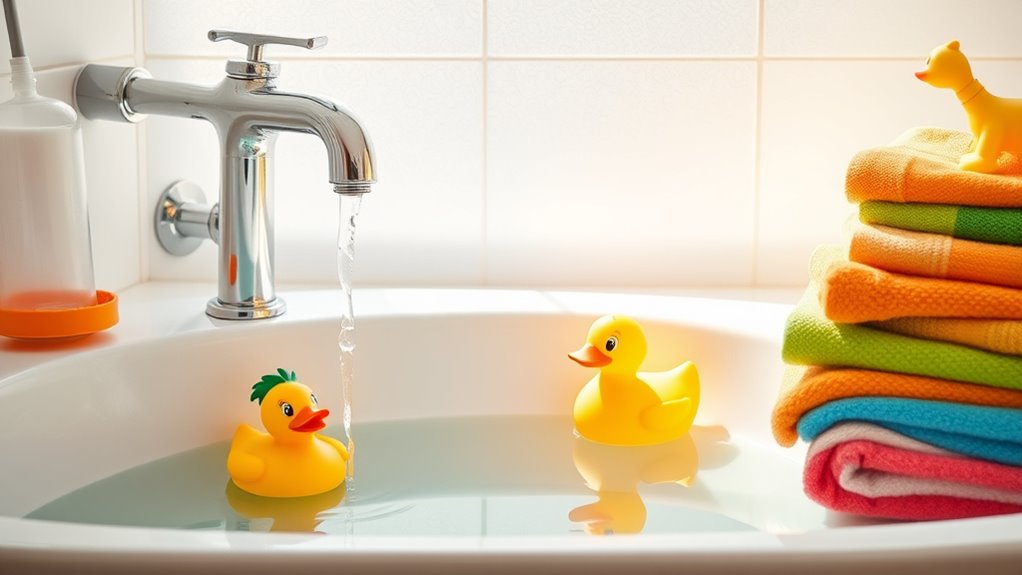Bath time safety rules are vital to keeping your child safe. Always supervise your child closely and never leave them unattended, even for a moment. Check the water temperature to ensure it’s warm, ideally around 100°F. Use non-slip mats and keep all bath supplies within easy reach. Choose age-appropriate toys and clean them regularly. After the bath, drain the tub immediately and keep the bathroom warm to prevent chilling. Want to know more about keeping bath time fun and safe?
Key Takeaways
- Always supervise children during bath time; never leave them unattended, even for a moment.
- Test the water temperature before bathing, ensuring it’s around 100°F (38°C) to prevent burns.
- Use non-slip mats or decals in the tub to reduce the risk of slipping accidents.
- Choose age-appropriate bath toys and regularly inspect them for safety and cleanliness.
- Immediately drain the tub after use and keep the bathroom warm to prevent chilling.

Bath time can be a fun and relaxing experience for both you and your child, but it’s crucial to prioritize safety. The most important rule is constant supervision. Never leave your child unattended in the bath, even for a moment. Drowning can happen in just a few inches of water. Make sure you ignore distractions like phones or doorbells during this time to maintain your focus.
Prioritize safety during bath time by ensuring constant supervision; never leave your child unattended, even for a moment.
If you can, having two adults present is ideal; one can stay distraction-free while the other attends to the child. If you need to step away, quickly towel-off your little one and take them with you.
Water temperature is another essential safety aspect. Always ensure the bath water is warm, ideally around 100°F (38°C), never hot. Test the water using your elbow or wrist to check for sensitivity. Swirl the water to prevent hot spots and maintain a consistent temperature. Additionally, consider installing safety locks on hot water taps to avoid accidental scalding. Setting your water heater to 120°F or less is a proactive step to prevent burns.
When preparing the tub, keep water levels appropriate for your child’s age. For infants, around 2 inches of water is sufficient, while toddlers should have the water reaching their bellybutton. Using non-slip mats or decals is a must to prevent slipping. Preventing slips and falls can be further enhanced by supervising children closely when entering and exiting the tub.
Install cushioned faucet covers to protect against bumps, and use tub guards to cushion sharp edges. Before starting bath time, ensure all supplies are within reach so you won’t have to leave the child unattended.
Choose mild, tear-free soaps and shampoos to protect your child’s sensitive skin and eyes. Ensure that any bath toys are age-appropriate and large enough to avoid choking hazards. Regularly clean and inspect toys for mold or damage, and check for recalls to ensure safety.
Electrical appliances should remain out of the bathroom during bath time, and medications or cleaning products need to be securely locked away. Installing toilet locks can prevent accidents, and consider a lock on the bathroom door to avoid unsupervised entry.
After bath time, drain the tub immediately to prevent slips. Keep the bathroom warm to avoid chilling, and make sure your child is thoroughly dried and dressed. Even after the bath, continue supervision as children can still be slippery.
Finally, clean the bathroom to maintain a safe environment for future baths.
Frequently Asked Questions
What Age Is Appropriate for a Child to Bathe Alone?
Determining when your child can bathe alone depends on their maturity and ability to follow safety rules.
Generally, kids around age 7.5 are seen as ready for solo baths. However, some children as young as 5 or 6 might start gaining independence but still need supervision.
Assess your child’s readiness and set clear rules to ensure safety.
How Can I Prevent Slips and Falls in the Bathtub?
To prevent slips and falls in the bathtub, you can start by placing non-slip mats inside the tub for better traction.
Consider applying non-slip coatings to the floor and using textured tiles to enhance grip.
Installing grab bars offers extra support, while keeping the bathroom dry and clean reduces hazards.
You might also add adhesive anti-slip strips for a quick fix.
Regularly check for soap residue, as it can make surfaces slippery.
Are Bath Toys Safe for My Child to Use?
Are bath toys safe for your child? They can be fun, but they also pose risks.
Microbial growth is common in bath toys, so regular cleaning and drying are essential. Check for mold or small parts that could be choking hazards.
Ensure the toys are age-appropriate and made from safe materials. Supervise your child during bath time to prevent accidents, and always stay aware of the potential dangers that come with bath play.
What Should I Do if My Child Gets Water in Their Ears?
If your child gets water in their ears, act quickly and calmly.
Tilt their head to one side to help the water drain out. You can gently pull their earlobe down to open the ear canal. Use a soft towel to pat the outer ear dry.
Avoid using cotton swabs, as they can push water further in. If symptoms like pain or itchiness develop, consult a doctor for advice.
How Often Should I Clean the Bathtub for Safety?
You should clean your bathtub regularly to keep it safe and hygienic. Aim for weekly disinfection to eliminate harmful bacteria and a deep clean monthly to tackle soap scum.
If multiple people use the tub, increase cleaning frequency. Also, consider the bathtub material, as some may require gentler cleaning methods.
Regular maintenance not only ensures safety but also prolongs the life of your tub, making bath time more enjoyable for everyone.
Conclusion
As you wrap up bath time, remember that the water’s gentle embrace symbolizes both comfort and caution. Just like a lighthouse guiding ships through rocky waters, your vigilance ensures safety in this serene space. By following these updated rules, you’re not just protecting your loved ones; you’re creating a sanctuary where joy and security coexist. So, let the splashes be a reminder that with every careful moment, you’re nurturing their happiness and well-being.









